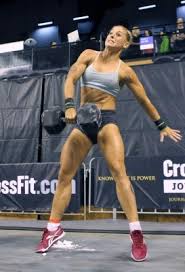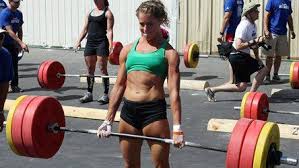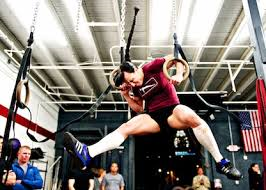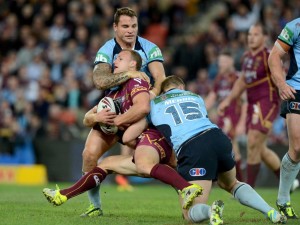 Progress requires process. A three-word, semi-alliterative sentence that describes most of life; it’s something I conceptualize when I consult with CrossFitters. Unfortunately, their philosophy hinges on process’ antithesis—constant variation.
Progress requires process. A three-word, semi-alliterative sentence that describes most of life; it’s something I conceptualize when I consult with CrossFitters. Unfortunately, their philosophy hinges on process’ antithesis—constant variation.
The randomness that they champion is ironically their downfall—the body requires consistent inputs to make lasting adaptations, a fact detrimentally ignored. But if process is applied to CrossFit’s current lexicon of desired abilities, greater progress is made—better performance, fewer injuries.
Through the process of layering abilities—movement, strength, skill and fitness—a better CrossFit athlete emerges.
SAID Still Exists
Specific adaptations to imposed demands—it’s a phrase ladled not-so-sparingly on to the cortex in exercise science courses. It’s a concept based on stress; the body wants to accommodate, and super-compensate, the stressors it’s exposed to. Problem is if you stress it too much, or offer too many non-compatible stressors, i.e. lots of simultaneous strength and endurance training, it won’t efficiently adapt to anything; you’ve offered nothing specific. Hence the invention of block periodization.
I don’t adhere to strict, one-quality block periodization, and I especially don’t believe in it as application to our current problem. But concurrent training with highlighted qualities is advantageous for many-a-athlete—especially CrossFit folk.
Concurrent training simultaneously develops multiple physical qualities—i.e. strength, mobility, power, conditioning. However, one or two qualities are emphasized while others play subservient roles. Perfect for athletes that display more than strength or power during competition.
Simultaneously turning the volume up to eleven on each quality creates physiological white noise—thinking otherwise is delusional.
What’s the solution? Layer qualities and prioritize highlights.
Layering Qualities
Two basic questions need satisfaction before we further this dialog:
- Do you move well enough to handle heavy loading (in terms of weight and in terms of volume)?
- Have you achieved lifting skill beyond proficiency?
Listen up, Michael Jackson; take a long look at the man in the mirror when you answer these questions. If you can’t confidently answer yes to either question, take a look at yourself and then make a change. Or, better yet, employ a qualified coach to evaluate your unloaded movement and your lift ability. (P.S. A qualified coach isn’t a gentleman—or gentle-lady—that took a weekend cert last year and bought a franchise.)
Capacity is gained when movement is efficient—exploring capacity while using shitty movement is a useless assessment of your capabilities, invalid and injurious.
Once you’ve met some movement markers—squatting below parallel without the aid of load comes to mind—and you’re hitting solid lift execution, we can proceed into quality layering and capacity exploration.
Until then, however, there are screen doors on submarines that make more sense than testing your strength, or endurance, capacity with any lift or skill.
Strength: The Bottom of the Layer Cake
 So many questions are answered with the phrase get stronger. It works in question form as well. For the next few sentences, I’ll be your Alex Trebek.
So many questions are answered with the phrase get stronger. It works in question form as well. For the next few sentences, I’ll be your Alex Trebek.
Improve injury resilience. What is get stronger?
Use less energy while completing a task. What is get stronger?
Increase the body’s ability to display all other qualities. What is, once again, get stronger?
Here’s the thing about strength, it’s like an engine block—you have to mold a solid block before you make modifications. It’s best to mold a v-12 before you start looking for accessory upgrades.
Once you have a solid block it’s easier to attach a turbo—the fuel injector adds another performance element. Et cetera, et cetera, et cetera.
Allegories aside—strength is the neurological, and tissue resiliency, foundation that enhances the body’s ability to develop and display speed, power, endurance, etc. The inter- and intra-muscular coordination that escorts strength to the brain, and back again, enhances our ability to learn complex movement skills—gymnastics and Olympic lifts are principal illustrations.
How about strength markers?
Squat and deadlift at least twice your bodyweight, bench your one and a half times your bodyweight  and press weight just shy of your bodyweight. If you can’t hit these marks, you’re not ready for the other demands CrossFit places on you.
 Aerobic Power and Cardiac Output
Aerobic just missed making George Carlin’s seven dirty words you can never say on television list. It was bumped by piss. It’s been ascribed effeminate and emasculating attributes and superpowers like turning men into skirt-flipping fem-folk—the de-creditors ignore the man-machines with highly-tuned aerobic systems that turn caving teeth in into an endurance activity.
Choose to subjectively consider aerobic training derogatory, that’s fine, but first consider what we objectively know about the aerobic system and how it affects training—especially CrossFit’s fatiguing jaunts.
We’re mostly concerned with aerobic power—the aerobic system’s ability to quickly generate energy. It’s the quality that bodes high-intensity performance without reliance on the anaerobic system. Tap into the anaerobic system and fatigue sullies your man-parts quicker than any slow paced, three mile run.
Develop aerobic power by increasing oxygen supply to muscles and by increasing the muscles ability to use said oxygen. Here’s the point of contention you’ve been waiting for: enhancing the heart’s ability to supply the muscles with oxygen requires long, slow bouts of exercise. Yikes!
These long, slow bouts of cardiac output training develop the heart’s ability to supply the muscles with oxygen via eccentric ventricular loading and development of the outlying vascular linkage. The heart fills with blood, cardiac muscle stretches and the arteries and veins develop as more blood is pumped to them.
The question begs: can’t these qualities be trained with high-intensity training? No. Jet the heart-rate above 150 and the heart contracts too quickly to hold enough blood to stretch the ventricle; cardiac muscle doesn’t stretch, the blood doesn’t pool, the effect is lost.
Cardiac output training requires staunch attention to heart rate—it lives in the zone between 120 and 150. It also requires time; ten minutes of calisthenics isn’t enough to load the heart and promote adaptation. Enhancing cardiac output means devoting forty-five to ninety minutes at a heart rate between 120 and 150—high-intensity’s antithesis.
To utilize the increased oxygen supply provided by improved cardiac output, we need a training stimulus that advances muscle’s oxygen utilization. This magic happens in the heart rate zones below anaerobic threshold—or in the 150’s-160’s. Joel Jamieson’s High-Intensity Continuous Training (HICT) method works wonders to meet this end.
HICT employs high-resistance exercises done slowly and continuously for sets of ten to twenty minutes. The slow speeds ensure that the exercise is done for a long period without stopping—or reaching anaerobic threshold—while high-resistance recruits fast-twitch fibers, cultivating their endurance.
Lunges with a weight-vest, or up a steep hill, work famously for HICT. Other great options are box step ups or twenty to thirty RPMs on a high-resistance spin bike.
Devoting time to aerobic power development via cardiac output and HICT trains the body to perform at high intensities while limiting fatigue. Greater endurance and work capacity is yours—as is improved recovery. Every athlete that plays with fatigue should devote time to aerobic power during the training year; but this work is especially important for folks new to the box and for those with resting heart rates on the north side of sixty-some beats per minute.
I’m not saying that aerobic development is all that folks need—far from it. But it seems that folks are doing enough work at and above anaerobic threshold; adding high-intensity conditioning volume won’t bolster performance or longevity.
If you want to do constantly varied, high-intensity functional movements, lay the aerobic groundwork first. You’ll adapt and perform better.
Build Skill, Not Fatigue
 Motor learning requires a fatigue-free environment; asking your body to complete a complex task while it’s exhausted won’t teach it a thing. Your brain will call you an asshole and figure out the easiest way to accomplish the task—which, most likely, won’t be the safest or most form-enhancing way.
Motor learning requires a fatigue-free environment; asking your body to complete a complex task while it’s exhausted won’t teach it a thing. Your brain will call you an asshole and figure out the easiest way to accomplish the task—which, most likely, won’t be the safest or most form-enhancing way.
Unless you are a full-time, competitive gymnast, or Olympic lifter, you’re nowhere near mastery. Hell, folks that devote their lives to developing in those athletic realms aren’t masters. It takes a perfect storm of genetics, coaching, mind-set and practice and time to master any skill. Something most of us—especially those developing multiple qualities at once—just don’t have.
The short version? You’re still learning.
Complex physical learning is near-impossible in an environment flush with lactic acid and filled with screaming vigor. That’s not to saysuch an environment isn’t productive for personal growth, it’s just not going to hone your technical skill. It’s analogous to any sport—good coaches aren’t going to introduce new skills, or refine important ones, when fatigue owns the body.
A fatigue-free environment exists at the beginning of a session during the first half of the training week. Neurologically you’re fresh because the session’s just begun and residual fatigue is low because it’s not been accumulated from several training sessions. This is the time most-appropriately devoted to building technical skills—gymnastics and the finer points of the barbell lifts.
That’s not to say that technical skills aren’t addressed every day, but big points are best addressed early in the week while smaller ones are trained throughout the rest of the week—while still practiced early in the training session.
Until technical skill is beyond proficient—which takes more than a few introductory workouts—including a lift that requires said skill in a fatiguing workout is irresponsible. Train technically early in the session and use other means to train strength and fitness.
Don’t Compete Every Time You Train
I’ve befriended and trained quite a few rugby players—some of which formerly employed CrossFit as their strength and conditioning means. Being curious—and considering that I’m missing something—I always ask why.
Here’s the common answer:
Because it’s the only training I’ve found that replicates the feeling I get while playing rugby.
(I’ve taken a paraphrasing liberty.)
 The first time this statement hit me, it kind of made sense. Then, I thought, and I said no, shit no, man. I believe someone should get their ass kicked for something like that.
The first time this statement hit me, it kind of made sense. Then, I thought, and I said no, shit no, man. I believe someone should get their ass kicked for something like that.
Saturday’s a rugby day—unless you’re immersed in tournament play, then you may play more than once—and the other six days are guided by preparation for Saturday’s competition; as it goes with sports that place a huge physical demand on the body, because they beat the shit out of it.
Competing every session is high-frequency bodily trashing—it’s also a bad idea. The nervous system is crushed and bodily tissues can’t regenerate in a form conducive to adaptation; the technical progression we chatted about is also moot.
The ever-continuing competition seems to stem from the ‘don’t be a pussy’ mindset; somehow if you don’t bleed from your eyes and anus during each training session your mettle is kaput. I’ve heard a few misguided souls bellow irrationalities like, ‘well, this is how Navy SEALs train.’ Do they? If so, they should make changes. And, more importantly, you’re not a Navy SEAL, Steve, you’re an accountant.
Want to avoid being a pussy? Avoid being manipulated into doing a bunch of stupid shit because a lot of your peers—that don’t really understand what they’re doing—say it’s cool. Instead, focus on what you need to improve and put your full gusto into it. It could be slow cardio; it could be extra attention to your second pull on your clean. Either way, it doesn’t mean your soft, it means that you’re focused on performance and accomplishing the necessary task at hand.
Should we stretch physical limits?—absolutely. But we stretch them intelligently and after we’ve obtained the necessary prerequisites—good movement, strength, technical skill.
The Trashcan Is Still Calling
Challenges often exist somewhere between ambition and masochism; ambition because fifty-fifty odds motivate us to achieve something we’re not sure we can accomplish, masochism because the process, and the wake, is torturous.
Let’s say you’ve bought in on the above info—develop strength, enhance your aerobic system and harness skill fatigue-free—but you still have the ambitious-masochistic urge to train your body into the trashcan, what do you do? Follow the neural-metabolic continuum.
A Week: From Neural to Metabolic
The neural-metabolic continuum is a guideline for structuring an exercise session and training week. Neurologically demanding training is placed at the beginning of a session and week; as the session, and week, progresses, metabolic demand increases.
Two simple examples are Olympic lifts and a 5k run. Olympic lifts find a home on the extreme neurological end of the continuum. The 5k resides modestly in a ranch house set on 1.5 acres in metabolicville.
With solid examples of each end of the spectrum, consider the training week using the concurrent training model. Heavy strength work and minute skill work live at the beginning of the week. Moderate-intensity strength training and moderate-intensity metabolic work find home in the middle of the week. If you choose to offer pain residence, sell him the house at the end of the street—a.k.a. the end of the training week. Be sure, also, to devote the most volume to the quality you’re training to develop.
Trashcan workouts require more recovery—more time, more nutrients, more rest. The fatigue they impose diminishes neurological efficiency—making technical skill acquisition and high force output impossibilities. For these reasons, hard-fought, gut-wrenching challenge workouts must come at the end of a training week—if you must crush yourself, do it on Friday and not Monday.
Unless you’re close to competition, and harnessing specificity, there’s no reason based in training logic to complete technical lift workouts hell bent on tossing your cookies. Low-load, low-skill and bodyweight exercises are appropriate selections. Exercises framed by these criteria are not as potentially injurious, nor do they interfere with the technical work done earlier in the week.
Baking Your Layer Cake
Constant variation isn’t progress reality.
I fear that some of you abhor what I say—this isn’t CrossFit. If you’re thinking in terms of WODs and the uncertainty of each workout, you’re right. But, under this model, you’re developing all the qualities that CrossFit endears, and you’re preparing your body to handle eventual random stimuli introductions.
So, let’s congeal our dialog into something actionable.
Consider the SAID principle, denote the physical quality that requires the most attention and prioritize it while maintaining the other qualities. After ensuring clean movement, strength development is usually the best starting point.
Think in a yearly progression. Early in the training year, build strength and cardiac output—these two adaptations coincide well. (Think Westside Barbell and GPP.) As you progress through training add in more aerobic power work and anaerobic conditioning. Test yourself periodically with benchmark workouts.
When competition approaches—say twelve weeks out—increase specificity and include more of the benchmark workouts. All the while, plan your training based on the neural-metabolic continuum and build the necessary finite skills—gymnastics, Olympic lifting, etc.
Progressively layer the qualities that make the body resilient to random stimuli—movement, strength, skill and fitness—and your process will reward you.
References
Jamieson, J. (2009). The Aerobic Energy System. Ultimate MMA Conditioning (). : Performance Sports Inc..
Â
Â
Â
(15939)